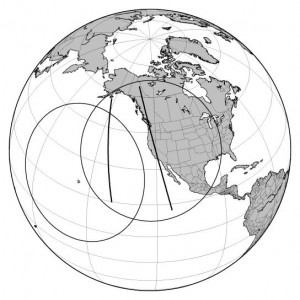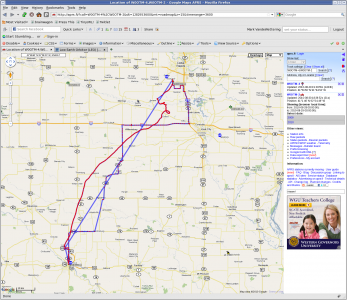A couple of weeks ago, I blogged that a group of students were planning to photograph the final launch of the shuttle Discovery from a high altitude balloon. What’s remarkable is that they succeeded. Click the link and surf on over to find what a couple of Android phones can do at 100K feet.
Category Archives: Amateur Satellite
Students to photograph Discovery flyby at 100,000 feet | TG Daily
Interesting. A group of students are launching a high altitude balloon “some miles” from the launch site of the Shuttle Discovery at Cape Kennedy, and will be streaming the video of the event as recorded by a pair of Android phones on board. I suspect that any video so streamed will be less than stellar, but I like the basic idea. I’ll have to check back and see how they did.
Students to photograph Discovery flyby at 100,000 feet | TG Daily.
Bummer! No Wednesday deployment of ARISSat-1
The Southgate Amateur Radio News is reporting that ARRISSAT-1 will not be deployed during an EVA from the ISS this week as previously planned. It now appears that it will remain on board until July.
No Wednesday deployment of ARISSat-1 | Southgate Amateur Radio News.
3. AMSAT learned on Friday morning, 11 FEB 11 that the deployment of the ARISSat-1 satellite had been removed from the RSA EVA 28 timeline by RSC-Energia management. NASA was informed that the ARISSat-1 deployment would be deferred to a later RS EVA, due to changes in the tasks associated with the configuration of RS payloads to be performed during RS EVA 28.
Subsequently, RSC-Energia informed NASA that deployment of ARISSat-1 will be added to RSC EVA 29 currently scheduled for July 2011.
FUNcube SDR video
I want one. I tried to get one, but the last batch sold out in 1 minute, which made me about 3 minutes too late.
AMSAT-UK FUNcube SDR video | Southgate Amateur Radio News.
httpvh://www.youtube.com/watch?v=xFZGlqKPPQo
They are currently in short supply, as they are being built by hand. Here’s hoping they introduce some extra capacity soon so we can all get one.
Android In Spaaaace!
I tweeted this earlier, but in case you aren’t subscribed to my twitter feed (user brainwagon) then you should check it out: some Google engineers sent one of their mascots to over 100K feet altitude along with several Android phones to record the experience. The video is awesome.
Ground tracks of satellite passes…
Every once in a while, I feel like making high quality pictures of ground tracks of satellites. The Generic Mapping Toolkit is handy, especially when combined with the pyephem library.
The thick line is the ground track of the amateur satellite AO-51, at any point in its next pass where it is visible from my home location. My idea is to script this up into a generic satellite prediction utility that I can access from my webpage. Stay tuned.
Addendum: I’m particularly interested in passes which might allow me to communicate with Hawaii. Here is a similar map, showing two passes of AO-51 (both passes start from south and move north) and also show the footprints of both San Francisco and Honolulu Hawaii. Any portion of the satellite path which is common to both circles should allow a CA-HI QSO to occur.
An AO-51 recording, and an attempt at a QSO…
Well, it’s been quite some time since I tried to work any of the FM birds, but I dusted off my TH-D7A, my voice recorder and my Arrow antenna, and decided to give it a go. It was pretty busy, and as usual I found it a bit difficult to get in. I got myself in the downlink once, and KB6LTY responded, but I couldn’t get through to confirm the QSO. Oh well. I’ll give SO-50 a try later, it is usually a bit more civilized there, and we have an 85 degree pass coming up shortly.
Until then, here’s a recording of the pass, a bit scratchy in the beginning, then it gets better.
NanoSail-D Update
It appears that the solar sail cubesat NanoSail-D that was recently launched may not have deployed properly: they haven’t been able to track it or contact as of yet. Bummer. I’ve been intrigued by solar sail technology for quite some time. Here’s hoping they figure out what went wrong, but bummer thusfar.
NanoSail-D Mission Status Update for Dec. 10 (NASA Hack Space).
Congratulations to SpaceX, and a new Cubesat!
Lost in yesterday’s thrilling launch of the SpaceX Falcon-9/Dragon launch was that during their flight, they also apparently deployed a cubesat: CAERUS (which is apparently Greek for “opportunity”). It has a 900mw FM AFSK beacon downlink on 437.600, and operates under the amateur callsign KJ6FIX. I have not as yet been able to locate TLEs for the satellite, so I’m not sure of its orbit, period and the like, but it might be good to try to give it a listen.
Information Sciences Institute – CAERUS.
Addendum: The Falcon9 also carried a nanosatellite for the Army.
The BPSK1000 Telemetry Modem for ARISSat-1
The legendary Phil Karn, KA9Q is apparently the brains behind the digital telemetry modem that will be used aboard the ARISSat-1, a satellite designed to be tossed off the ISS sometime next year. From his paper:
ARISSat-1 will carry a new telemetry modulation and coding scheme, BPSK1000, designed to handle the severe fading often encountered with low orbit satellites without attitude control. Its performance and the link budgets for the ARISSat-1 spacecraft are such that reliable reception should require only a simple whip or ground plane antenna, a conventional 2m SSB receiver, and a reasonably modern personal computer with audio A/D input.
BPSK1000 uses differential binary phase shift keying (DBPSK) at a channel symbol rate of 1 kHz in a SSB bandwidth. With constraint length 7, rate ½ forward error correction (FEC), the user data rate is about 500 bits/sec. HDLC framing provides application flexibility (including the ability to carry AX.25 in other applications) and a deep (16 second) convolutional interleaver provides strong protection against fading.
The BPSK1000 Telemetry Modem for ARISSat-1
I wasn’t able to find any links to the software, but I’m not panicking, since the launch is several months away, but worth looking into.
While googling, I found that KE9V had mentioned this a couple of days ago. One of his comments asked “Why not just use AFSK/FM like all the traditional packet satellites?” The reason is simple: it doesn’t work as well. The way these things are usually evaluated is in terms of Eb/N0, which is the “energy per bit, per unit of spectral noise density”, usually defined for a given error rate (10^-5 seems typical). For AFSK/FM at 1200 baud, Eb/N0 works out to 24db. For Karn’s proposed technique, it works out to a mere 6.7db. In practical terms, this means the satellite can operate at much lower power levels (it’s going to only be sending out 100mw) and the signal can still be reliably detected by omnidirectional antennas.
Very cool.
Nano-Satellite Launch Challenge
Apparently NASA is sponsoring the development of nanosatellite launch capabilities by sponsoring a two million dollar prize purse for the first team to launch a standard 1U Cubesat into orbit (payloads must complete at least one orbit) twice in a week.
NASA – Nano-Satellite Launch Challenge.
I found out about this by reading the Team Phoenicia blog, which announced an upcoming seminar on the Nanosatellite Launcher Challenge in cooperation with the Menlo Park Techshop. I’d love to attend, but sadly I’ve got another cool event booked for that weekend.
Draft Agenda for the Team Phoenicia/Techshop Nanosatellite Launcher Seminar
Another nifty balloon project…
Luke Gesissbuhler did a balloon launch, lofting an HD video camera and an Apple iPhone to lofty heights before recovering them. Very nice. The footage right after burst was kind of cool: I was wondering whether the fragments of the balloon or parachute tangled with the camera: perhaps dangling the camera on a longer tether could reduce the possibility of them tangling. Still, it all worked out in the end (and rather brilliantly!).
Inspirational.
Homemade Spacecraft from Luke Geissbuhler on Vimeo.
iHAB Iowa High Altitude Balloon
I was on the #hamradio channel on IRC this morning where people were watghing the progress of the Iowa High Altitude Ballon (IHAB) operating with callsign W0OTM-4. We saw it drift up to an altitude of about 88K feet, before descending. They had a 20m beacon, an APRS beacon running on 2m, and a cellular telephone tracker. Very cool. Hopefully, they’ll have some photos soon.
iHAB Iowa High Altitude Balloon.
Addendum: Using aprs, i tracked both the balloon and the chase vehicle (callsign W0OTM-2) and showed the complete groundtrack of both. Pretty neat.
CUSF Landing Predictor 2.0
Cambridge University has an amazing webpage that provides a web based front end to a weather balloon flight prediction program. It can even save output in Google Earth’s KML format. Very cool, very useful, saved for future perusal.
Images of Objects in Orbit
Ralf Vandebergh has a really interesting web page, where he shows pictures of the ISS and Shuttle missions taken with a 10″ Newtonian telescope. The detail is really amazing.
Images of ISS, Space Shuttle and other spaceflight objects by Ralf Vandebergh
George Tarsoudis has similar equipment, and produces similarly impressive results:


